Analyzing the Economic Impact of COVID-19 on Singapore: A Study
VerifiedAdded on 2021/01/27
|9
|3334
|64
Report
AI Summary
This report investigates the profound economic effects of the COVID-19 pandemic on Singapore. It examines the impact on key industries such as aviation, tourism, and manufacturing, highlighting the dramatic decline in tourist arrivals, the challenges faced by Singapore Airlines (SIA), and the fluctuations in the manufacturing sector's GDP. The report analyzes the changes in supply and demand, particularly for essential goods like face masks, and the subsequent impact on prices. It also delves into the labor market, detailing rising unemployment rates, retrenchments, and the government's policy responses, including stimulus initiatives. The analysis incorporates data from various sources, including government reports, Google search trends, and industry forecasts, to provide a comprehensive overview of Singapore's economic resilience during the pandemic and the challenges it faces in its recovery. The report concludes with an overview of stabilization policies and their effectiveness in addressing the economic disruptions caused by the pandemic, offering insights into the long-term implications for the country's economy.
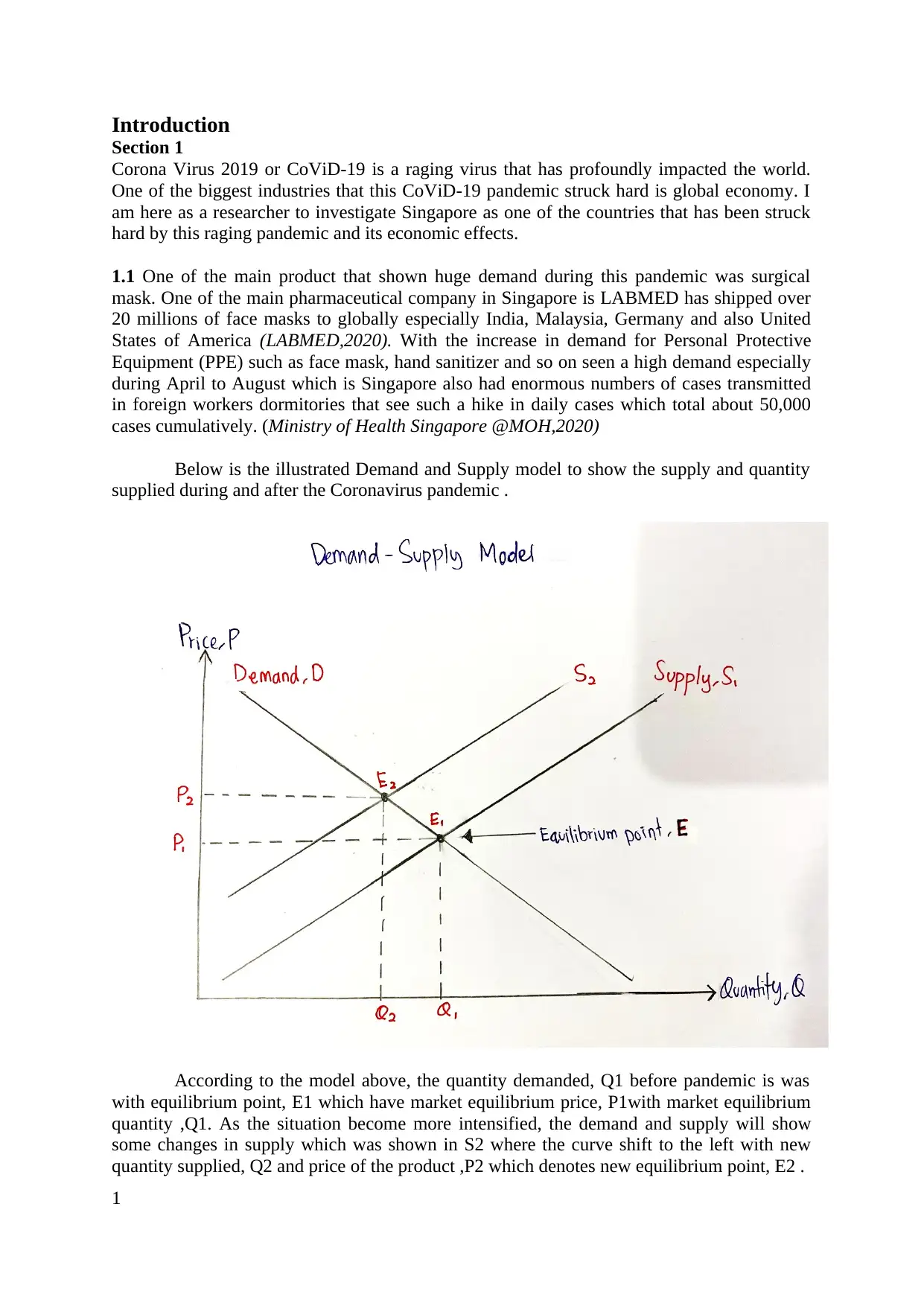
Introduction
Section 1
Corona Virus 2019 or CoViD-19 is a raging virus that has profoundly impacted the world.
One of the biggest industries that this CoViD-19 pandemic struck hard is global economy. I
am here as a researcher to investigate Singapore as one of the countries that has been struck
hard by this raging pandemic and its economic effects.
1.1 One of the main product that shown huge demand during this pandemic was surgical
mask. One of the main pharmaceutical company in Singapore is LABMED has shipped over
20 millions of face masks to globally especially India, Malaysia, Germany and also United
States of America (LABMED,2020). With the increase in demand for Personal Protective
Equipment (PPE) such as face mask, hand sanitizer and so on seen a high demand especially
during April to August which is Singapore also had enormous numbers of cases transmitted
in foreign workers dormitories that see such a hike in daily cases which total about 50,000
cases cumulatively. (Ministry of Health Singapore @MOH,2020)
Below is the illustrated Demand and Supply model to show the supply and quantity
supplied during and after the Coronavirus pandemic .
According to the model above, the quantity demanded, Q1 before pandemic is was
with equilibrium point, E1 which have market equilibrium price, P1with market equilibrium
quantity ,Q1. As the situation become more intensified, the demand and supply will show
some changes in supply which was shown in S2 where the curve shift to the left with new
quantity supplied, Q2 and price of the product ,P2 which denotes new equilibrium point, E2 .
1
Section 1
Corona Virus 2019 or CoViD-19 is a raging virus that has profoundly impacted the world.
One of the biggest industries that this CoViD-19 pandemic struck hard is global economy. I
am here as a researcher to investigate Singapore as one of the countries that has been struck
hard by this raging pandemic and its economic effects.
1.1 One of the main product that shown huge demand during this pandemic was surgical
mask. One of the main pharmaceutical company in Singapore is LABMED has shipped over
20 millions of face masks to globally especially India, Malaysia, Germany and also United
States of America (LABMED,2020). With the increase in demand for Personal Protective
Equipment (PPE) such as face mask, hand sanitizer and so on seen a high demand especially
during April to August which is Singapore also had enormous numbers of cases transmitted
in foreign workers dormitories that see such a hike in daily cases which total about 50,000
cases cumulatively. (Ministry of Health Singapore @MOH,2020)
Below is the illustrated Demand and Supply model to show the supply and quantity
supplied during and after the Coronavirus pandemic .
According to the model above, the quantity demanded, Q1 before pandemic is was
with equilibrium point, E1 which have market equilibrium price, P1with market equilibrium
quantity ,Q1. As the situation become more intensified, the demand and supply will show
some changes in supply which was shown in S2 where the curve shift to the left with new
quantity supplied, Q2 and price of the product ,P2 which denotes new equilibrium point, E2 .
1
Paraphrase This Document
Need a fresh take? Get an instant paraphrase of this document with our AI Paraphraser
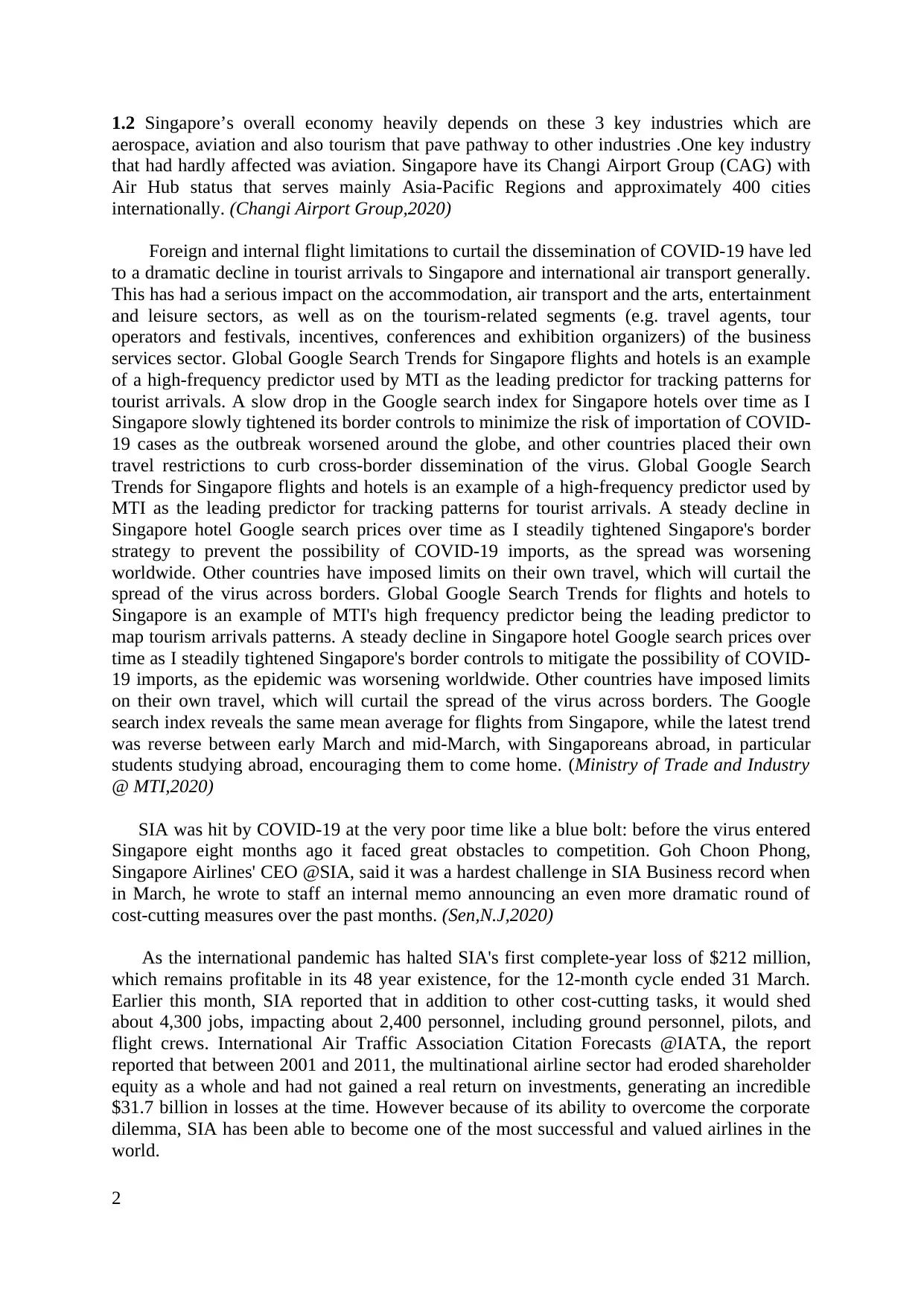
1.2 Singapore’s overall economy heavily depends on these 3 key industries which are
aerospace, aviation and also tourism that pave pathway to other industries .One key industry
that had hardly affected was aviation. Singapore have its Changi Airport Group (CAG) with
Air Hub status that serves mainly Asia-Pacific Regions and approximately 400 cities
internationally. (Changi Airport Group,2020)
Foreign and internal flight limitations to curtail the dissemination of COVID-19 have led
to a dramatic decline in tourist arrivals to Singapore and international air transport generally.
This has had a serious impact on the accommodation, air transport and the arts, entertainment
and leisure sectors, as well as on the tourism-related segments (e.g. travel agents, tour
operators and festivals, incentives, conferences and exhibition organizers) of the business
services sector. Global Google Search Trends for Singapore flights and hotels is an example
of a high-frequency predictor used by MTI as the leading predictor for tracking patterns for
tourist arrivals. A slow drop in the Google search index for Singapore hotels over time as I
Singapore slowly tightened its border controls to minimize the risk of importation of COVID-
19 cases as the outbreak worsened around the globe, and other countries placed their own
travel restrictions to curb cross-border dissemination of the virus. Global Google Search
Trends for Singapore flights and hotels is an example of a high-frequency predictor used by
MTI as the leading predictor for tracking patterns for tourist arrivals. A steady decline in
Singapore hotel Google search prices over time as I steadily tightened Singapore's border
strategy to prevent the possibility of COVID-19 imports, as the spread was worsening
worldwide. Other countries have imposed limits on their own travel, which will curtail the
spread of the virus across borders. Global Google Search Trends for flights and hotels to
Singapore is an example of MTI's high frequency predictor being the leading predictor to
map tourism arrivals patterns. A steady decline in Singapore hotel Google search prices over
time as I steadily tightened Singapore's border controls to mitigate the possibility of COVID-
19 imports, as the epidemic was worsening worldwide. Other countries have imposed limits
on their own travel, which will curtail the spread of the virus across borders. The Google
search index reveals the same mean average for flights from Singapore, while the latest trend
was reverse between early March and mid-March, with Singaporeans abroad, in particular
students studying abroad, encouraging them to come home. (Ministry of Trade and Industry
@ MTI,2020)
SIA was hit by COVID-19 at the very poor time like a blue bolt: before the virus entered
Singapore eight months ago it faced great obstacles to competition. Goh Choon Phong,
Singapore Airlines' CEO @SIA, said it was a hardest challenge in SIA Business record when
in March, he wrote to staff an internal memo announcing an even more dramatic round of
cost-cutting measures over the past months. (Sen,N.J,2020)
As the international pandemic has halted SIA's first complete-year loss of $212 million,
which remains profitable in its 48 year existence, for the 12-month cycle ended 31 March.
Earlier this month, SIA reported that in addition to other cost-cutting tasks, it would shed
about 4,300 jobs, impacting about 2,400 personnel, including ground personnel, pilots, and
flight crews. International Air Traffic Association Citation Forecasts @IATA, the report
reported that between 2001 and 2011, the multinational airline sector had eroded shareholder
equity as a whole and had not gained a real return on investments, generating an incredible
$31.7 billion in losses at the time. However because of its ability to overcome the corporate
dilemma, SIA has been able to become one of the most successful and valued airlines in the
world.
2
aerospace, aviation and also tourism that pave pathway to other industries .One key industry
that had hardly affected was aviation. Singapore have its Changi Airport Group (CAG) with
Air Hub status that serves mainly Asia-Pacific Regions and approximately 400 cities
internationally. (Changi Airport Group,2020)
Foreign and internal flight limitations to curtail the dissemination of COVID-19 have led
to a dramatic decline in tourist arrivals to Singapore and international air transport generally.
This has had a serious impact on the accommodation, air transport and the arts, entertainment
and leisure sectors, as well as on the tourism-related segments (e.g. travel agents, tour
operators and festivals, incentives, conferences and exhibition organizers) of the business
services sector. Global Google Search Trends for Singapore flights and hotels is an example
of a high-frequency predictor used by MTI as the leading predictor for tracking patterns for
tourist arrivals. A slow drop in the Google search index for Singapore hotels over time as I
Singapore slowly tightened its border controls to minimize the risk of importation of COVID-
19 cases as the outbreak worsened around the globe, and other countries placed their own
travel restrictions to curb cross-border dissemination of the virus. Global Google Search
Trends for Singapore flights and hotels is an example of a high-frequency predictor used by
MTI as the leading predictor for tracking patterns for tourist arrivals. A steady decline in
Singapore hotel Google search prices over time as I steadily tightened Singapore's border
strategy to prevent the possibility of COVID-19 imports, as the spread was worsening
worldwide. Other countries have imposed limits on their own travel, which will curtail the
spread of the virus across borders. Global Google Search Trends for flights and hotels to
Singapore is an example of MTI's high frequency predictor being the leading predictor to
map tourism arrivals patterns. A steady decline in Singapore hotel Google search prices over
time as I steadily tightened Singapore's border controls to mitigate the possibility of COVID-
19 imports, as the epidemic was worsening worldwide. Other countries have imposed limits
on their own travel, which will curtail the spread of the virus across borders. The Google
search index reveals the same mean average for flights from Singapore, while the latest trend
was reverse between early March and mid-March, with Singaporeans abroad, in particular
students studying abroad, encouraging them to come home. (Ministry of Trade and Industry
@ MTI,2020)
SIA was hit by COVID-19 at the very poor time like a blue bolt: before the virus entered
Singapore eight months ago it faced great obstacles to competition. Goh Choon Phong,
Singapore Airlines' CEO @SIA, said it was a hardest challenge in SIA Business record when
in March, he wrote to staff an internal memo announcing an even more dramatic round of
cost-cutting measures over the past months. (Sen,N.J,2020)
As the international pandemic has halted SIA's first complete-year loss of $212 million,
which remains profitable in its 48 year existence, for the 12-month cycle ended 31 March.
Earlier this month, SIA reported that in addition to other cost-cutting tasks, it would shed
about 4,300 jobs, impacting about 2,400 personnel, including ground personnel, pilots, and
flight crews. International Air Traffic Association Citation Forecasts @IATA, the report
reported that between 2001 and 2011, the multinational airline sector had eroded shareholder
equity as a whole and had not gained a real return on investments, generating an incredible
$31.7 billion in losses at the time. However because of its ability to overcome the corporate
dilemma, SIA has been able to become one of the most successful and valued airlines in the
world.
2
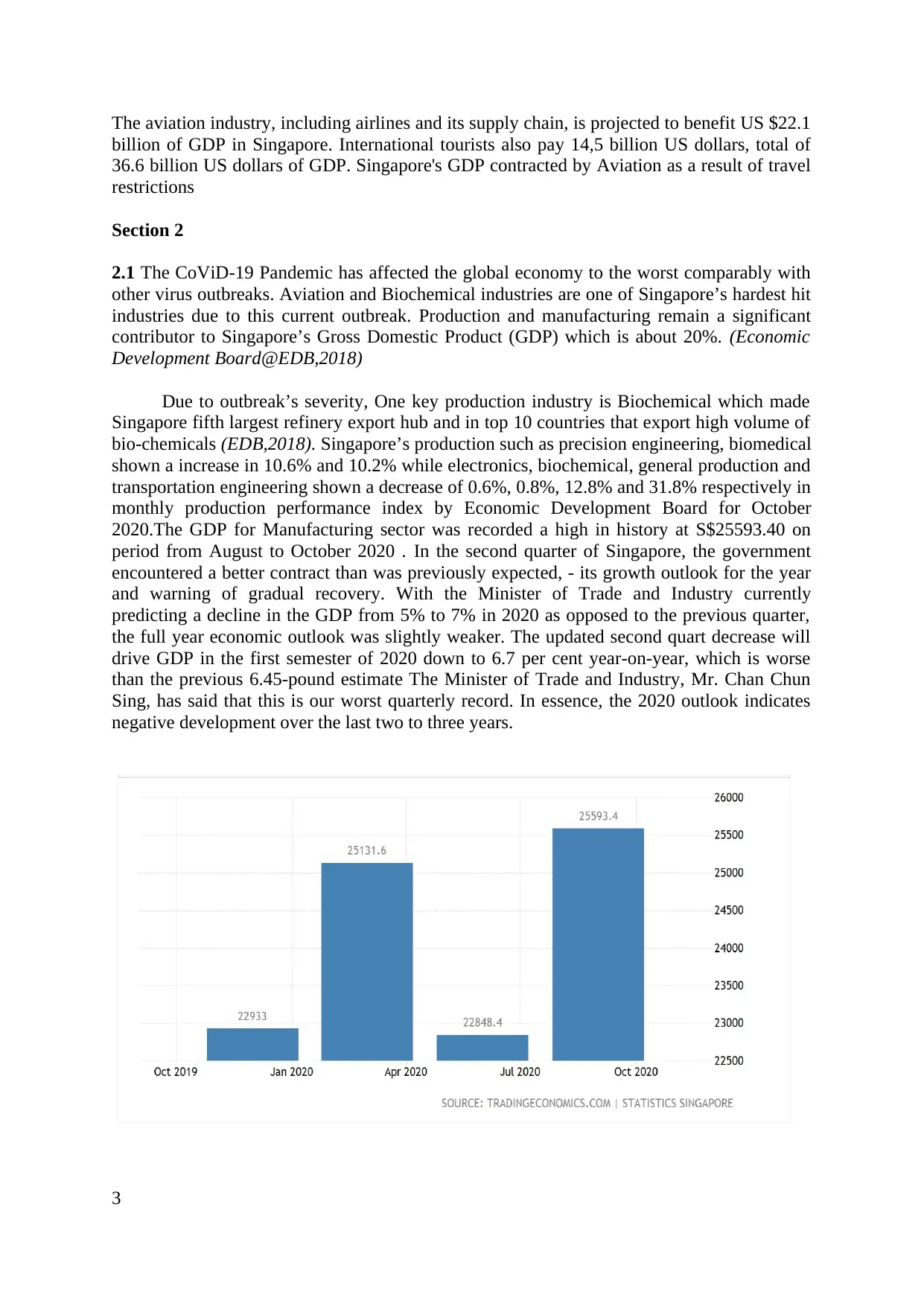
The aviation industry, including airlines and its supply chain, is projected to benefit US $22.1
billion of GDP in Singapore. International tourists also pay 14,5 billion US dollars, total of
36.6 billion US dollars of GDP. Singapore's GDP contracted by Aviation as a result of travel
restrictions
Section 2
2.1 The CoViD-19 Pandemic has affected the global economy to the worst comparably with
other virus outbreaks. Aviation and Biochemical industries are one of Singapore’s hardest hit
industries due to this current outbreak. Production and manufacturing remain a significant
contributor to Singapore’s Gross Domestic Product (GDP) which is about 20%. (Economic
Development Board@EDB,2018)
Due to outbreak’s severity, One key production industry is Biochemical which made
Singapore fifth largest refinery export hub and in top 10 countries that export high volume of
bio-chemicals (EDB,2018). Singapore’s production such as precision engineering, biomedical
shown a increase in 10.6% and 10.2% while electronics, biochemical, general production and
transportation engineering shown a decrease of 0.6%, 0.8%, 12.8% and 31.8% respectively in
monthly production performance index by Economic Development Board for October
2020.The GDP for Manufacturing sector was recorded a high in history at S$25593.40 on
period from August to October 2020 . In the second quarter of Singapore, the government
encountered a better contract than was previously expected, - its growth outlook for the year
and warning of gradual recovery. With the Minister of Trade and Industry currently
predicting a decline in the GDP from 5% to 7% in 2020 as opposed to the previous quarter,
the full year economic outlook was slightly weaker. The updated second quart decrease will
drive GDP in the first semester of 2020 down to 6.7 per cent year-on-year, which is worse
than the previous 6.45-pound estimate The Minister of Trade and Industry, Mr. Chan Chun
Sing, has said that this is our worst quarterly record. In essence, the 2020 outlook indicates
negative development over the last two to three years.
3
billion of GDP in Singapore. International tourists also pay 14,5 billion US dollars, total of
36.6 billion US dollars of GDP. Singapore's GDP contracted by Aviation as a result of travel
restrictions
Section 2
2.1 The CoViD-19 Pandemic has affected the global economy to the worst comparably with
other virus outbreaks. Aviation and Biochemical industries are one of Singapore’s hardest hit
industries due to this current outbreak. Production and manufacturing remain a significant
contributor to Singapore’s Gross Domestic Product (GDP) which is about 20%. (Economic
Development Board@EDB,2018)
Due to outbreak’s severity, One key production industry is Biochemical which made
Singapore fifth largest refinery export hub and in top 10 countries that export high volume of
bio-chemicals (EDB,2018). Singapore’s production such as precision engineering, biomedical
shown a increase in 10.6% and 10.2% while electronics, biochemical, general production and
transportation engineering shown a decrease of 0.6%, 0.8%, 12.8% and 31.8% respectively in
monthly production performance index by Economic Development Board for October
2020.The GDP for Manufacturing sector was recorded a high in history at S$25593.40 on
period from August to October 2020 . In the second quarter of Singapore, the government
encountered a better contract than was previously expected, - its growth outlook for the year
and warning of gradual recovery. With the Minister of Trade and Industry currently
predicting a decline in the GDP from 5% to 7% in 2020 as opposed to the previous quarter,
the full year economic outlook was slightly weaker. The updated second quart decrease will
drive GDP in the first semester of 2020 down to 6.7 per cent year-on-year, which is worse
than the previous 6.45-pound estimate The Minister of Trade and Industry, Mr. Chan Chun
Sing, has said that this is our worst quarterly record. In essence, the 2020 outlook indicates
negative development over the last two to three years.
3
⊘ This is a preview!⊘
Do you want full access?
Subscribe today to unlock all pages.

Trusted by 1+ million students worldwide
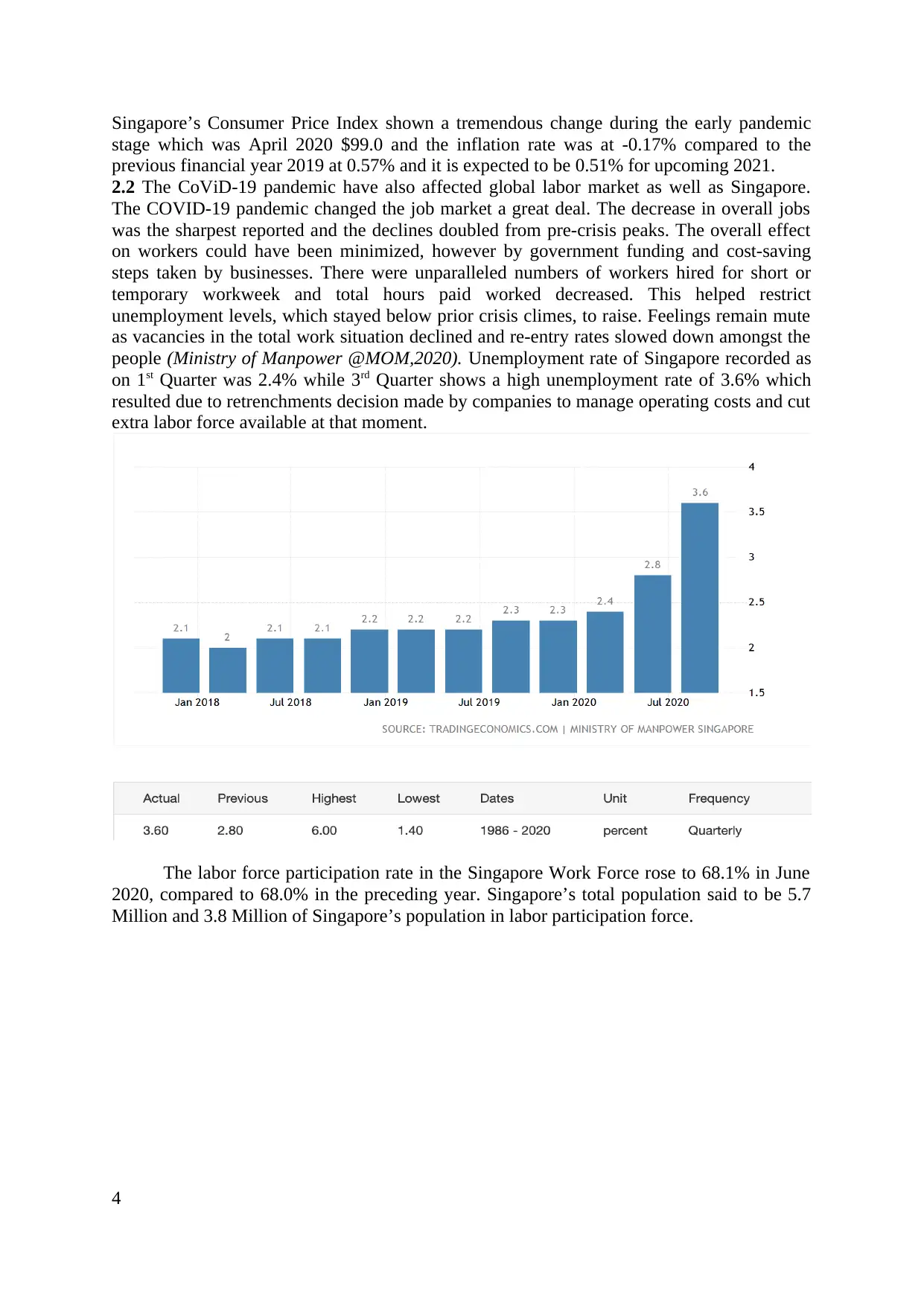
Singapore’s Consumer Price Index shown a tremendous change during the early pandemic
stage which was April 2020 $99.0 and the inflation rate was at -0.17% compared to the
previous financial year 2019 at 0.57% and it is expected to be 0.51% for upcoming 2021.
2.2 The CoViD-19 pandemic have also affected global labor market as well as Singapore.
The COVID-19 pandemic changed the job market a great deal. The decrease in overall jobs
was the sharpest reported and the declines doubled from pre-crisis peaks. The overall effect
on workers could have been minimized, however by government funding and cost-saving
steps taken by businesses. There were unparalleled numbers of workers hired for short or
temporary workweek and total hours paid worked decreased. This helped restrict
unemployment levels, which stayed below prior crisis climes, to raise. Feelings remain mute
as vacancies in the total work situation declined and re-entry rates slowed down amongst the
people (Ministry of Manpower @MOM,2020). Unemployment rate of Singapore recorded as
on 1st Quarter was 2.4% while 3rd Quarter shows a high unemployment rate of 3.6% which
resulted due to retrenchments decision made by companies to manage operating costs and cut
extra labor force available at that moment.
The labor force participation rate in the Singapore Work Force rose to 68.1% in June
2020, compared to 68.0% in the preceding year. Singapore’s total population said to be 5.7
Million and 3.8 Million of Singapore’s population in labor participation force.
4
stage which was April 2020 $99.0 and the inflation rate was at -0.17% compared to the
previous financial year 2019 at 0.57% and it is expected to be 0.51% for upcoming 2021.
2.2 The CoViD-19 pandemic have also affected global labor market as well as Singapore.
The COVID-19 pandemic changed the job market a great deal. The decrease in overall jobs
was the sharpest reported and the declines doubled from pre-crisis peaks. The overall effect
on workers could have been minimized, however by government funding and cost-saving
steps taken by businesses. There were unparalleled numbers of workers hired for short or
temporary workweek and total hours paid worked decreased. This helped restrict
unemployment levels, which stayed below prior crisis climes, to raise. Feelings remain mute
as vacancies in the total work situation declined and re-entry rates slowed down amongst the
people (Ministry of Manpower @MOM,2020). Unemployment rate of Singapore recorded as
on 1st Quarter was 2.4% while 3rd Quarter shows a high unemployment rate of 3.6% which
resulted due to retrenchments decision made by companies to manage operating costs and cut
extra labor force available at that moment.
The labor force participation rate in the Singapore Work Force rose to 68.1% in June
2020, compared to 68.0% in the preceding year. Singapore’s total population said to be 5.7
Million and 3.8 Million of Singapore’s population in labor participation force.
4
Paraphrase This Document
Need a fresh take? Get an instant paraphrase of this document with our AI Paraphraser
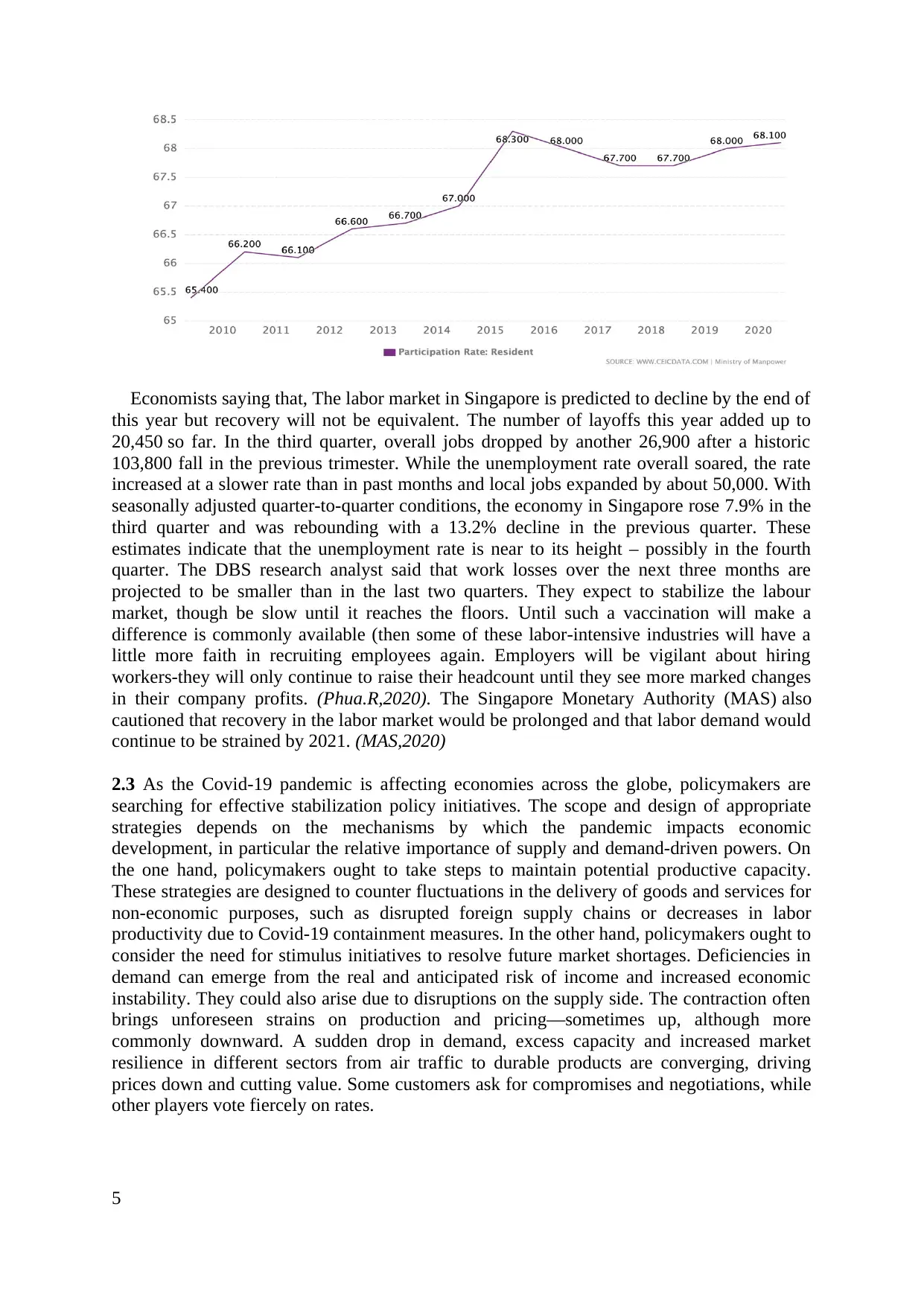
Economists saying that, The labor market in Singapore is predicted to decline by the end of
this year but recovery will not be equivalent. The number of layoffs this year added up to
20,450 so far. In the third quarter, overall jobs dropped by another 26,900 after a historic
103,800 fall in the previous trimester. While the unemployment rate overall soared, the rate
increased at a slower rate than in past months and local jobs expanded by about 50,000. With
seasonally adjusted quarter-to-quarter conditions, the economy in Singapore rose 7.9% in the
third quarter and was rebounding with a 13.2% decline in the previous quarter. These
estimates indicate that the unemployment rate is near to its height – possibly in the fourth
quarter. The DBS research analyst said that work losses over the next three months are
projected to be smaller than in the last two quarters. They expect to stabilize the labour
market, though be slow until it reaches the floors. Until such a vaccination will make a
difference is commonly available (then some of these labor-intensive industries will have a
little more faith in recruiting employees again. Employers will be vigilant about hiring
workers-they will only continue to raise their headcount until they see more marked changes
in their company profits. (Phua.R,2020). The Singapore Monetary Authority (MAS) also
cautioned that recovery in the labor market would be prolonged and that labor demand would
continue to be strained by 2021. (MAS,2020)
2.3 As the Covid-19 pandemic is affecting economies across the globe, policymakers are
searching for effective stabilization policy initiatives. The scope and design of appropriate
strategies depends on the mechanisms by which the pandemic impacts economic
development, in particular the relative importance of supply and demand-driven powers. On
the one hand, policymakers ought to take steps to maintain potential productive capacity.
These strategies are designed to counter fluctuations in the delivery of goods and services for
non-economic purposes, such as disrupted foreign supply chains or decreases in labor
productivity due to Covid-19 containment measures. In the other hand, policymakers ought to
consider the need for stimulus initiatives to resolve future market shortages. Deficiencies in
demand can emerge from the real and anticipated risk of income and increased economic
instability. They could also arise due to disruptions on the supply side. The contraction often
brings unforeseen strains on production and pricing—sometimes up, although more
commonly downward. A sudden drop in demand, excess capacity and increased market
resilience in different sectors from air traffic to durable products are converging, driving
prices down and cutting value. Some customers ask for compromises and negotiations, while
other players vote fiercely on rates.
5
this year but recovery will not be equivalent. The number of layoffs this year added up to
20,450 so far. In the third quarter, overall jobs dropped by another 26,900 after a historic
103,800 fall in the previous trimester. While the unemployment rate overall soared, the rate
increased at a slower rate than in past months and local jobs expanded by about 50,000. With
seasonally adjusted quarter-to-quarter conditions, the economy in Singapore rose 7.9% in the
third quarter and was rebounding with a 13.2% decline in the previous quarter. These
estimates indicate that the unemployment rate is near to its height – possibly in the fourth
quarter. The DBS research analyst said that work losses over the next three months are
projected to be smaller than in the last two quarters. They expect to stabilize the labour
market, though be slow until it reaches the floors. Until such a vaccination will make a
difference is commonly available (then some of these labor-intensive industries will have a
little more faith in recruiting employees again. Employers will be vigilant about hiring
workers-they will only continue to raise their headcount until they see more marked changes
in their company profits. (Phua.R,2020). The Singapore Monetary Authority (MAS) also
cautioned that recovery in the labor market would be prolonged and that labor demand would
continue to be strained by 2021. (MAS,2020)
2.3 As the Covid-19 pandemic is affecting economies across the globe, policymakers are
searching for effective stabilization policy initiatives. The scope and design of appropriate
strategies depends on the mechanisms by which the pandemic impacts economic
development, in particular the relative importance of supply and demand-driven powers. On
the one hand, policymakers ought to take steps to maintain potential productive capacity.
These strategies are designed to counter fluctuations in the delivery of goods and services for
non-economic purposes, such as disrupted foreign supply chains or decreases in labor
productivity due to Covid-19 containment measures. In the other hand, policymakers ought to
consider the need for stimulus initiatives to resolve future market shortages. Deficiencies in
demand can emerge from the real and anticipated risk of income and increased economic
instability. They could also arise due to disruptions on the supply side. The contraction often
brings unforeseen strains on production and pricing—sometimes up, although more
commonly downward. A sudden drop in demand, excess capacity and increased market
resilience in different sectors from air traffic to durable products are converging, driving
prices down and cutting value. Some customers ask for compromises and negotiations, while
other players vote fiercely on rates.
5
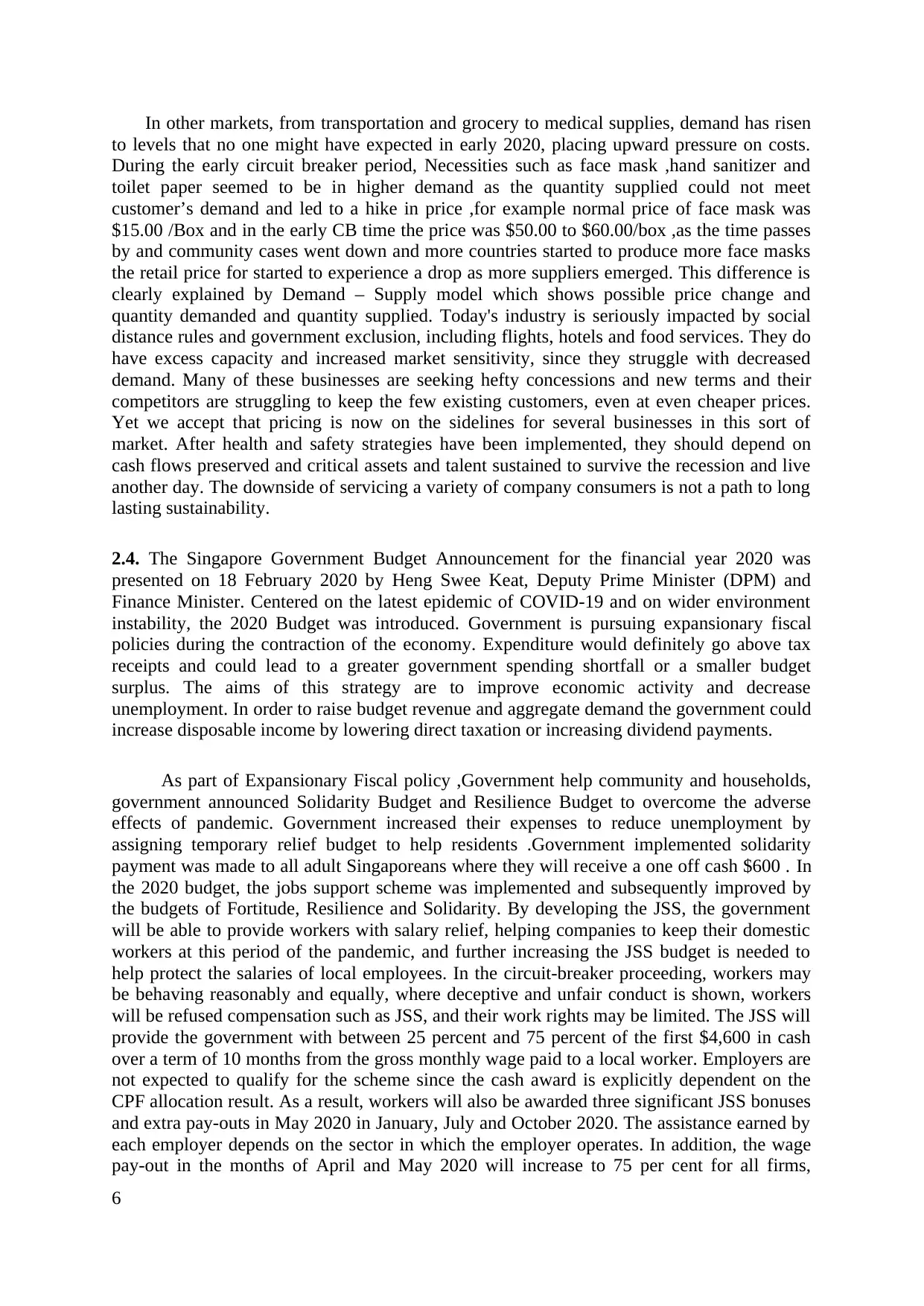
In other markets, from transportation and grocery to medical supplies, demand has risen
to levels that no one might have expected in early 2020, placing upward pressure on costs.
During the early circuit breaker period, Necessities such as face mask ,hand sanitizer and
toilet paper seemed to be in higher demand as the quantity supplied could not meet
customer’s demand and led to a hike in price ,for example normal price of face mask was
$15.00 /Box and in the early CB time the price was $50.00 to $60.00/box ,as the time passes
by and community cases went down and more countries started to produce more face masks
the retail price for started to experience a drop as more suppliers emerged. This difference is
clearly explained by Demand – Supply model which shows possible price change and
quantity demanded and quantity supplied. Today's industry is seriously impacted by social
distance rules and government exclusion, including flights, hotels and food services. They do
have excess capacity and increased market sensitivity, since they struggle with decreased
demand. Many of these businesses are seeking hefty concessions and new terms and their
competitors are struggling to keep the few existing customers, even at even cheaper prices.
Yet we accept that pricing is now on the sidelines for several businesses in this sort of
market. After health and safety strategies have been implemented, they should depend on
cash flows preserved and critical assets and talent sustained to survive the recession and live
another day. The downside of servicing a variety of company consumers is not a path to long
lasting sustainability.
2.4. The Singapore Government Budget Announcement for the financial year 2020 was
presented on 18 February 2020 by Heng Swee Keat, Deputy Prime Minister (DPM) and
Finance Minister. Centered on the latest epidemic of COVID-19 and on wider environment
instability, the 2020 Budget was introduced. Government is pursuing expansionary fiscal
policies during the contraction of the economy. Expenditure would definitely go above tax
receipts and could lead to a greater government spending shortfall or a smaller budget
surplus. The aims of this strategy are to improve economic activity and decrease
unemployment. In order to raise budget revenue and aggregate demand the government could
increase disposable income by lowering direct taxation or increasing dividend payments.
As part of Expansionary Fiscal policy ,Government help community and households,
government announced Solidarity Budget and Resilience Budget to overcome the adverse
effects of pandemic. Government increased their expenses to reduce unemployment by
assigning temporary relief budget to help residents .Government implemented solidarity
payment was made to all adult Singaporeans where they will receive a one off cash $600 . In
the 2020 budget, the jobs support scheme was implemented and subsequently improved by
the budgets of Fortitude, Resilience and Solidarity. By developing the JSS, the government
will be able to provide workers with salary relief, helping companies to keep their domestic
workers at this period of the pandemic, and further increasing the JSS budget is needed to
help protect the salaries of local employees. In the circuit-breaker proceeding, workers may
be behaving reasonably and equally, where deceptive and unfair conduct is shown, workers
will be refused compensation such as JSS, and their work rights may be limited. The JSS will
provide the government with between 25 percent and 75 percent of the first $4,600 in cash
over a term of 10 months from the gross monthly wage paid to a local worker. Employers are
not expected to qualify for the scheme since the cash award is explicitly dependent on the
CPF allocation result. As a result, workers will also be awarded three significant JSS bonuses
and extra pay-outs in May 2020 in January, July and October 2020. The assistance earned by
each employer depends on the sector in which the employer operates. In addition, the wage
pay-out in the months of April and May 2020 will increase to 75 per cent for all firms,
6
to levels that no one might have expected in early 2020, placing upward pressure on costs.
During the early circuit breaker period, Necessities such as face mask ,hand sanitizer and
toilet paper seemed to be in higher demand as the quantity supplied could not meet
customer’s demand and led to a hike in price ,for example normal price of face mask was
$15.00 /Box and in the early CB time the price was $50.00 to $60.00/box ,as the time passes
by and community cases went down and more countries started to produce more face masks
the retail price for started to experience a drop as more suppliers emerged. This difference is
clearly explained by Demand – Supply model which shows possible price change and
quantity demanded and quantity supplied. Today's industry is seriously impacted by social
distance rules and government exclusion, including flights, hotels and food services. They do
have excess capacity and increased market sensitivity, since they struggle with decreased
demand. Many of these businesses are seeking hefty concessions and new terms and their
competitors are struggling to keep the few existing customers, even at even cheaper prices.
Yet we accept that pricing is now on the sidelines for several businesses in this sort of
market. After health and safety strategies have been implemented, they should depend on
cash flows preserved and critical assets and talent sustained to survive the recession and live
another day. The downside of servicing a variety of company consumers is not a path to long
lasting sustainability.
2.4. The Singapore Government Budget Announcement for the financial year 2020 was
presented on 18 February 2020 by Heng Swee Keat, Deputy Prime Minister (DPM) and
Finance Minister. Centered on the latest epidemic of COVID-19 and on wider environment
instability, the 2020 Budget was introduced. Government is pursuing expansionary fiscal
policies during the contraction of the economy. Expenditure would definitely go above tax
receipts and could lead to a greater government spending shortfall or a smaller budget
surplus. The aims of this strategy are to improve economic activity and decrease
unemployment. In order to raise budget revenue and aggregate demand the government could
increase disposable income by lowering direct taxation or increasing dividend payments.
As part of Expansionary Fiscal policy ,Government help community and households,
government announced Solidarity Budget and Resilience Budget to overcome the adverse
effects of pandemic. Government increased their expenses to reduce unemployment by
assigning temporary relief budget to help residents .Government implemented solidarity
payment was made to all adult Singaporeans where they will receive a one off cash $600 . In
the 2020 budget, the jobs support scheme was implemented and subsequently improved by
the budgets of Fortitude, Resilience and Solidarity. By developing the JSS, the government
will be able to provide workers with salary relief, helping companies to keep their domestic
workers at this period of the pandemic, and further increasing the JSS budget is needed to
help protect the salaries of local employees. In the circuit-breaker proceeding, workers may
be behaving reasonably and equally, where deceptive and unfair conduct is shown, workers
will be refused compensation such as JSS, and their work rights may be limited. The JSS will
provide the government with between 25 percent and 75 percent of the first $4,600 in cash
over a term of 10 months from the gross monthly wage paid to a local worker. Employers are
not expected to qualify for the scheme since the cash award is explicitly dependent on the
CPF allocation result. As a result, workers will also be awarded three significant JSS bonuses
and extra pay-outs in May 2020 in January, July and October 2020. The assistance earned by
each employer depends on the sector in which the employer operates. In addition, the wage
pay-out in the months of April and May 2020 will increase to 75 per cent for all firms,
6
⊘ This is a preview!⊘
Do you want full access?
Subscribe today to unlock all pages.

Trusted by 1+ million students worldwide
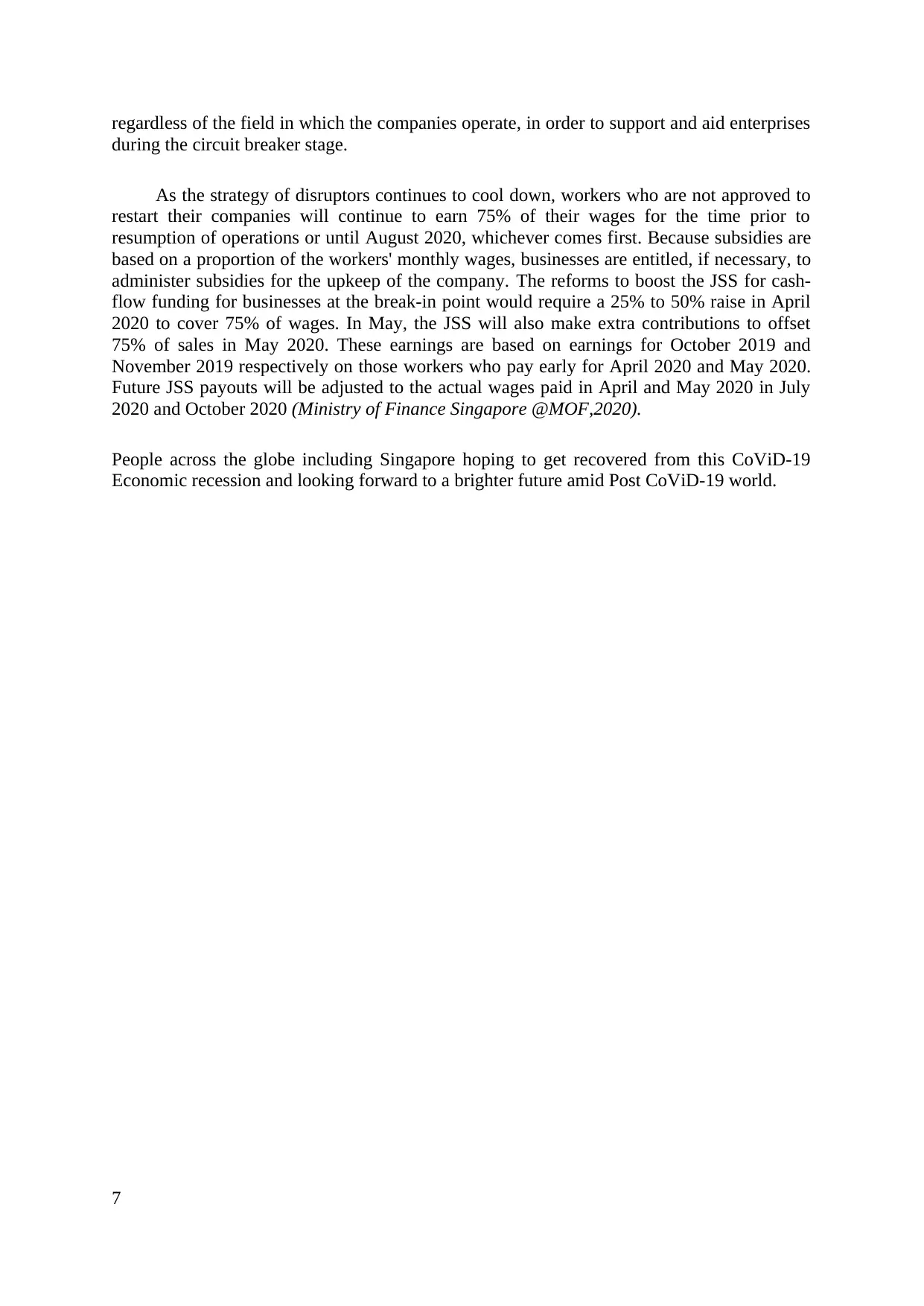
regardless of the field in which the companies operate, in order to support and aid enterprises
during the circuit breaker stage.
As the strategy of disruptors continues to cool down, workers who are not approved to
restart their companies will continue to earn 75% of their wages for the time prior to
resumption of operations or until August 2020, whichever comes first. Because subsidies are
based on a proportion of the workers' monthly wages, businesses are entitled, if necessary, to
administer subsidies for the upkeep of the company. The reforms to boost the JSS for cash-
flow funding for businesses at the break-in point would require a 25% to 50% raise in April
2020 to cover 75% of wages. In May, the JSS will also make extra contributions to offset
75% of sales in May 2020. These earnings are based on earnings for October 2019 and
November 2019 respectively on those workers who pay early for April 2020 and May 2020.
Future JSS payouts will be adjusted to the actual wages paid in April and May 2020 in July
2020 and October 2020 (Ministry of Finance Singapore @MOF,2020).
People across the globe including Singapore hoping to get recovered from this CoViD-19
Economic recession and looking forward to a brighter future amid Post CoViD-19 world.
7
during the circuit breaker stage.
As the strategy of disruptors continues to cool down, workers who are not approved to
restart their companies will continue to earn 75% of their wages for the time prior to
resumption of operations or until August 2020, whichever comes first. Because subsidies are
based on a proportion of the workers' monthly wages, businesses are entitled, if necessary, to
administer subsidies for the upkeep of the company. The reforms to boost the JSS for cash-
flow funding for businesses at the break-in point would require a 25% to 50% raise in April
2020 to cover 75% of wages. In May, the JSS will also make extra contributions to offset
75% of sales in May 2020. These earnings are based on earnings for October 2019 and
November 2019 respectively on those workers who pay early for April 2020 and May 2020.
Future JSS payouts will be adjusted to the actual wages paid in April and May 2020 in July
2020 and October 2020 (Ministry of Finance Singapore @MOF,2020).
People across the globe including Singapore hoping to get recovered from this CoViD-19
Economic recession and looking forward to a brighter future amid Post CoViD-19 world.
7
Paraphrase This Document
Need a fresh take? Get an instant paraphrase of this document with our AI Paraphraser
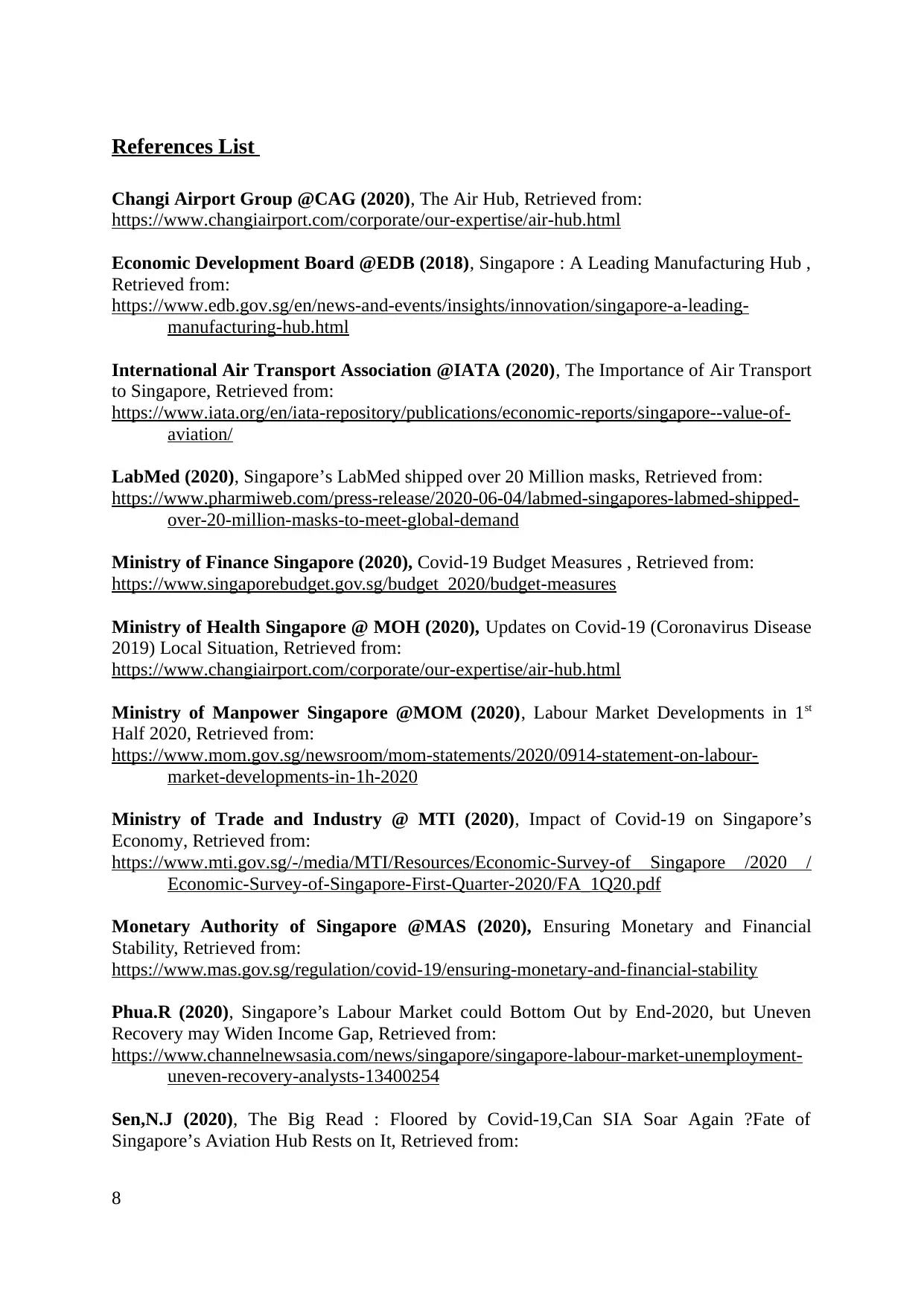
References List
Changi Airport Group @CAG (2020), The Air Hub, Retrieved from:
https://www.changiairport.com/corporate/our-expertise/air-hub.html
Economic Development Board @EDB (2018), Singapore : A Leading Manufacturing Hub ,
Retrieved from:
https://www.edb.gov.sg/en/news-and-events/insights/innovation/singapore-a-leading-
manufacturing-hub.html
International Air Transport Association @IATA (2020), The Importance of Air Transport
to Singapore, Retrieved from:
https://www.iata.org/en/iata-repository/publications/economic-reports/singapore--value-of-
aviation/
LabMed (2020), Singapore’s LabMed shipped over 20 Million masks, Retrieved from:
https://www.pharmiweb.com/press-release/2020-06-04/labmed-singapores-labmed-shipped-
over-20-million-masks-to-meet-global-demand
Ministry of Finance Singapore (2020), Covid-19 Budget Measures , Retrieved from:
https://www.singaporebudget.gov.sg/budget_2020/budget-measures
Ministry of Health Singapore @ MOH (2020), Updates on Covid-19 (Coronavirus Disease
2019) Local Situation, Retrieved from:
https://www.changiairport.com/corporate/our-expertise/air-hub.html
Ministry of Manpower Singapore @MOM (2020), Labour Market Developments in 1st
Half 2020, Retrieved from:
https://www.mom.gov.sg/newsroom/mom-statements/2020/0914-statement-on-labour-
market-developments-in-1h-2020
Ministry of Trade and Industry @ MTI (2020), Impact of Covid-19 on Singapore’s
Economy, Retrieved from:
https://www.mti.gov.sg/-/media/MTI/Resources/Economic-Survey-of Singapore /2020 /
Economic-Survey-of-Singapore-First-Quarter-2020/FA_1Q20.pdf
Monetary Authority of Singapore @MAS (2020), Ensuring Monetary and Financial
Stability, Retrieved from:
https://www.mas.gov.sg/regulation/covid-19/ensuring-monetary-and-financial-stability
Phua.R (2020), Singapore’s Labour Market could Bottom Out by End-2020, but Uneven
Recovery may Widen Income Gap, Retrieved from:
https://www.channelnewsasia.com/news/singapore/singapore-labour-market-unemployment-
uneven-recovery-analysts-13400254
Sen,N.J (2020), The Big Read : Floored by Covid-19,Can SIA Soar Again ?Fate of
Singapore’s Aviation Hub Rests on It, Retrieved from:
8
Changi Airport Group @CAG (2020), The Air Hub, Retrieved from:
https://www.changiairport.com/corporate/our-expertise/air-hub.html
Economic Development Board @EDB (2018), Singapore : A Leading Manufacturing Hub ,
Retrieved from:
https://www.edb.gov.sg/en/news-and-events/insights/innovation/singapore-a-leading-
manufacturing-hub.html
International Air Transport Association @IATA (2020), The Importance of Air Transport
to Singapore, Retrieved from:
https://www.iata.org/en/iata-repository/publications/economic-reports/singapore--value-of-
aviation/
LabMed (2020), Singapore’s LabMed shipped over 20 Million masks, Retrieved from:
https://www.pharmiweb.com/press-release/2020-06-04/labmed-singapores-labmed-shipped-
over-20-million-masks-to-meet-global-demand
Ministry of Finance Singapore (2020), Covid-19 Budget Measures , Retrieved from:
https://www.singaporebudget.gov.sg/budget_2020/budget-measures
Ministry of Health Singapore @ MOH (2020), Updates on Covid-19 (Coronavirus Disease
2019) Local Situation, Retrieved from:
https://www.changiairport.com/corporate/our-expertise/air-hub.html
Ministry of Manpower Singapore @MOM (2020), Labour Market Developments in 1st
Half 2020, Retrieved from:
https://www.mom.gov.sg/newsroom/mom-statements/2020/0914-statement-on-labour-
market-developments-in-1h-2020
Ministry of Trade and Industry @ MTI (2020), Impact of Covid-19 on Singapore’s
Economy, Retrieved from:
https://www.mti.gov.sg/-/media/MTI/Resources/Economic-Survey-of Singapore /2020 /
Economic-Survey-of-Singapore-First-Quarter-2020/FA_1Q20.pdf
Monetary Authority of Singapore @MAS (2020), Ensuring Monetary and Financial
Stability, Retrieved from:
https://www.mas.gov.sg/regulation/covid-19/ensuring-monetary-and-financial-stability
Phua.R (2020), Singapore’s Labour Market could Bottom Out by End-2020, but Uneven
Recovery may Widen Income Gap, Retrieved from:
https://www.channelnewsasia.com/news/singapore/singapore-labour-market-unemployment-
uneven-recovery-analysts-13400254
Sen,N.J (2020), The Big Read : Floored by Covid-19,Can SIA Soar Again ?Fate of
Singapore’s Aviation Hub Rests on It, Retrieved from:
8

https://www.channelnewsasia.com/news/singapore/sia-singapore-airlines-covid-19-aviation-
air-travel-hub-changi-131517742
9
air-travel-hub-changi-131517742
9
⊘ This is a preview!⊘
Do you want full access?
Subscribe today to unlock all pages.

Trusted by 1+ million students worldwide
1 out of 9
Your All-in-One AI-Powered Toolkit for Academic Success.
+13062052269
info@desklib.com
Available 24*7 on WhatsApp / Email
![[object Object]](/_next/static/media/star-bottom.7253800d.svg)
Unlock your academic potential
Copyright © 2020–2025 A2Z Services. All Rights Reserved. Developed and managed by ZUCOL.